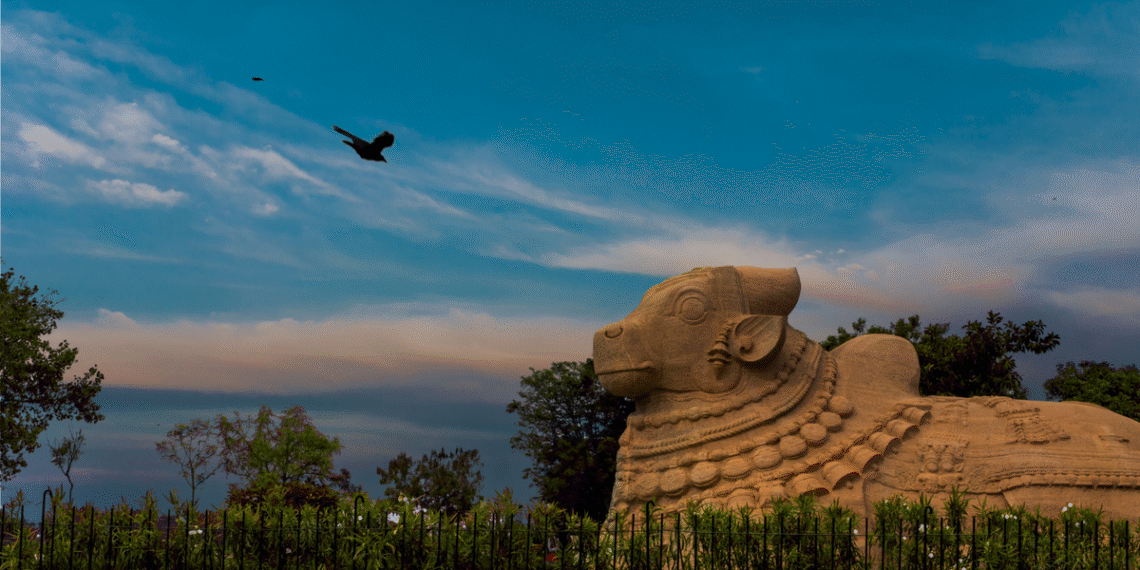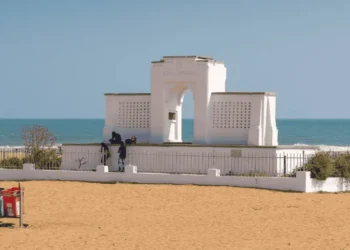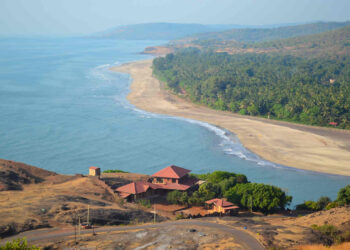Andhra Pradesh, a historic land in South India, holds many Hindu temples built by old dynasties like the Satavahanas, Cholas, and Vijayanagaras. These holy places, with their tall Dravidian gopurams and fine stone carvings, show the state’s deep faith and skill in building. From hills to quiet riverbanks, Andhra’s temples call pilgrims, scholars, and travelers, each sharing stories of ancient worship. Below are ten key temples in Andhra Pradesh, each with its own past, welcoming devotees and visitors from India and far away.
1. Tirumala Venkateswara Temple, Tirupati
On Tirupati’s seven hills in Chittoor district, the Tirumala Venkateswara Temple was built around the 8th century and is dedicated to Lord Venkateswara, a form of Lord Vishnu. It’s the world’s richest temple, with 50,000 visitors daily. The Dravidian gopuram, topped with a golden Ananda Nilayam, has carvings of Vishnu’s tales, made by Vijayanagara workers. The Brahmotsavam festival in September or October has chariot marches. With Pallava and Chola help, it’s Andhra’s main holy site. The temple’s laddus, given as prasadam, are special to devotees keeping promises.
2. Kanaka Durga Temple, Vijayawada
By the Krishna River on Indrakeeladri Hill, the Kanaka Durga Temple in Vijayawada, from the 8th century, honors Goddess Durga, the city’s protector. Its Dravidian tower and carvings of Shakti stories are clear. Old writings name it, and Navratri brings many for Durga Puja. A nearby Malleswara Swamy shrine adds to its holiness. The river’s calm and Chalukya-era links make it dear. Local tales say Durga kept Vijayawada safe from floods, making it more loved.
3. Srikalahasteeswara Temple, Srikalahasti
The Srikalahasteeswara Temple, 36 km from Tirupati in Chittoor district, began in the 5th century with the Pallavas and grew under Vijayanagara king Krishnadevaraya in 1516. It’s dedicated to Lord Shiva as Vayu Lingam, showing wind in the Pancha Bhoota Sthalams. Cut into a hill, its hundred-pillar hall and carvings of a spider, serpent, and elephant praising Shiva are fine. Known for Rahu-Ketu rituals, its Shivaratri festival is busy. Near Tirupati, it’s a big pilgrimage place.
4. Srisailam Mallikarjuna Swamy Temple, Srisailam
In the Nallamala Hills by the Krishna River, the Srisailam Mallikarjuna Swamy Temple, from the 6th century, is a Jyotirlinga and Shakti Peetha dedicated to Lord Shiva and Goddess Brahmaramba. Built by Vijayanagara’s Harihara Raya, its Dravidian gopuram and Mahabharata carvings keep old stories. Maha Shivaratri brings devotees for holy rites. With forests and Patala Ganga around, it’s key for Shaivites and Shaktas. Nearby tribes respect it, adding to its sacred air.
5. Simhachalam Temple, Visakhapatnam
On Simhachalam Hill, the Simhachalam Temple, from the 11th century, houses Lord Narasimha, Vishnu’s lion-man form. Its Kalinga, Chalukya, and Dravidian styles show fine carvings and tanks like Gangadhara. The Chandanotsavam festival, where sandalwood covers the idol, makes the air sweet. In Western Ghats greenery, its Chola-era roots are strong. The hilltop shows Visakhapatnam’s coast, adding to its holy feel.
6. Ahobilam Narasimha Swamy Temple, Kurnool
The Ahobilam Temple group in Kurnool’s Eastern Ghats, from the 8th century, has nine shrines dedicated to Lord Narasimha, tied to Vishnu’s fight with Hiranyakashipu. Stone carvings tell this story, with a 5-foot-3-inch Narasimha idol in the main shrine. Used for weddings, its rough paths and Chalukya style draw people. The Brahmotsavam festival has active rituals. The walk to upper shrines is tough but gives calm hill views.
7. Yaganti Uma Maheshwara Swamy Temple, Kurnool
The Yaganti Temple in Kurnool, from the 5th-6th centuries and helped by Vijayanagara’s Harihara Bukka Raya, is dedicated to Lord Shiva. Its Nandi statue, said to grow a little, interests visitors, along with a Pushkarini tank and caves like Agastya’s. Its Vaishnavite-Dravidian style and hill setting are clear. Maha Shivaratri has special prayers, mixing nature’s peace with faith. Local talk of the Nandi’s growth adds a sense of wonder.
8. Lepakshi Veerabhadra Temple, Anantapur
The Lepakshi Veerabhadra Temple in Anantapur, built in the 16th century, is dedicated to Lord Veerabhadra, a strong Shiva form. Its Vijayanagara style has a big stone Nandi and a hanging pillar that seems to float. Carvings and wall paintings tell holy stories. The February chariot festival brings many, and its art links to the Vijayanagara empire. The temple’s paintings draw those who study old art.
9. Amararama Temple, Amaravati
The Amararama Temple in Guntur, a Panchakrama Kshetra from the 2nd century, honors Lord Shiva as Amaralingeswara. By the Krishna River, its tall gopuram and carvings show Chola and Vijayanagara signs. A story says Indra placed the linga, which grew until a nail stopped it, leaving a blood mark. Maha Shivaratri is full of rites, and the river’s quiet adds holy charm. Its old past makes it a history treasure.
10. Kanipakam Vinayaka Temple, Chittoor
The Kanipakam Vinayaka Temple in Chittoor, from the 11th century, is dedicated to Lord Ganesha, whose self-made murti (idol) is said to grow. Built by the Cholas, its Dravidian style has carvings and a holy tank. The Maha Ganapathi Rathotsavam has big parades. Known for fixing disputes, its nearness to Tirupati makes it well-visited. People pray to Ganesha before big steps in life.
Practical Tips for Visiting
Andhra Pradesh gets hot, up to 30-40°F, with rains from June to September. November to February is cooler, around 21-28°F. It is best to go early in the morning to miss heat and crowds. You can wear clothes covering shoulders and knees. Photos are often not allowed inside the most temples. Be quiet during prayers and feel the divine touch of the divine. Festivals like Brahmotsavam and Navratri get full, so book buses or taxis and places to stay early for far places like Ahobilam.
Conclusion
Andhra Pradesh’s temples, from the great Tirumala Venkateswara to the calm Kanipakam Vinayaka, hold the state’s deep Hindu faith and esoteric art of the past. Built by dynasties like the Satavahanas, Cholas, and Vijayanagaras, these shrines have fine carvings, big designs, and holy rites that shape Andhra’s ways, calling devotees and visitors to their sacred grounds making these temples a must visit for any travelers as well.











